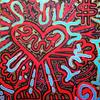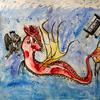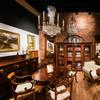Power Up: Corita Kent’s Heavenly Pop
- SACRAMENTO, California
- /
- December 27, 2017
The Crocker Art Museum in Sacramento, Calif., has announced the February 25 opening of Power Up: Corita Kent’s Heavenly Pop. This exhibition of 29 prints chronicles the artist’s most productive period during the mid-1960s, when her forceful imagery and message — and her unexpected calling as a nun — led to her greatest popularity. All but two works featured in this exhibition are from the Crocker’s permanent collection.
Said Lial Jones, the Museum's director and CEO, "We are delighted to have such remarkable depth of Corita Kent's work in our permanent collection, and to be able to show it in this exhibition. Her messages of peace and love are as timeless and vibrant as her art. We are proud to introduce new audiences to her work.”
Corita Kent (1918–1986) was an extraordinary printmaker whose bold, graphic images signaled the new spirit of the 1960s. At a time of great change, the nun, artist, and activist developed a unique, spiritually uplifting version of Pop art known for its poetic visual statements.
Born in Iowa as Frances Elizabeth Kent, Corita moved to Hollywood at the age of five, where she entered the Catholic school system. At 18, she took her vows and chose the name of Sister Mary Corita in the Sisters of the Immaculate Heart of Mary, a Catholic religious teaching institute for women. In 1947, after graduating from Immaculate Heart College, she returned as assistant faculty, and helped make the art department one of the most advanced in the country.
As an artist, her boldly colored prints began with unpretentious, expressionistic religious imagery and soon turned to abstraction and text. A pivotal moment in her artistic evolution came in 1962, when she first encountered the Pop Art of Andy Warhol. Corita, was deeply inspired by the experience, and as her career unfolded during a time of great cultural and religious upheaval, she felt she had found the perfect vehicle for her message of joy. Corita began to seek inspiration from the commercial art world, and in 1963, she began to introduce elements from advertising and signage into her prints. Though she had been influenced by many besides Warhol — writers, poets, and her designer/architect friends Charles and Ray Eames among them — Corita’s art, like Warhol’s, became an icon of a new age.
“For Corita, this form of artistic expression was a way to celebrate all of God’s creation,” said Crocker Art Museum curator William Breazeale. “As we view her work, we see that she explored the intersection of religion and daily life, as she found the holy in the everyday, and the everyday in the holy.”
1965 was a particularly significant year, as it marked the close of the Second Vatican Council, which sought to create a new relationship between the Catholic church and the contemporary world. As Corita had for decades, many within the church came to view Christian life in a modern way. During this same year, Corita produced the silkscreen life, in which she combined the graphic simplicity of LIFE magazine with a quote from a German theologian and a slogan for Lark cigarettes. His words contribute to the many levels of meaning in the print. Corita shows that LIFE magazine, daily life, and eternal life are all part of our world.
Corita’s search for God’s message led her to unusual places: the words of Pope John XXIII, A. A. Milne, Albert Camus, and Joan Baez, for example. As her silkscreens attracted more attention, her fame mushroomed. In 1967, she appeared on the cover of Newsweek, and released one of her most popular works, feelin’ groovy. The print combines traffic signs with quotes from the work of emerging poet Edward Field and musicians Simon and Garfunkel. The imagery, the quotes, and the title (which is the refrain from the Simon and Garfunkel song by the same name) belong to the secular, popular world of mid-1960s America. Yet read within a religious context, as the printmaker intended, they become a powerful metaphor for the human soul in peril, and trust in God as the hope for salvation.
At least as important as her printmaking was Corita’s teaching and activism, including an unrelenting protest against the Vietnam War. Her teaching was at least as revolutionary. A few of her art department rules:
- Consider everything an experiment.
- The only rule is work. If you work, it will lead to something.
- Always be around. Come or go to everything…. There should be new rules next week.
In 1968, at the height of her fame, Corita’s radical re-interpretations of traditional religious iconography irritated the conservative Cardinal McIntyre of the Los Angeles diocese. Disturbed by this, Corita asked to be released from her vows as a nun and left the church that same year.
After her following move to Boston, Corita continued her work as an artist in a quieter way, though still spreading her messages of joy. She continued to make prints and watercolors until she died of cancer in 1986.
“In these works Corita's creative spirit and her deep faith combine in art that is eye-catching and bright, but at the same time imbued with profound meaning," said Breazeale. "Her art, and her message of joy and justice, are well-suited to our times."
EXHIBITION ORGANIZER
This exhibition is organized by William Breazeale, curator at the Crocker Art Museum, with guest curator Michael Duncan.




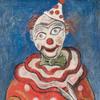


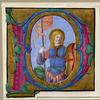



__Buffalo_Hunt100x100_c.jpg)
